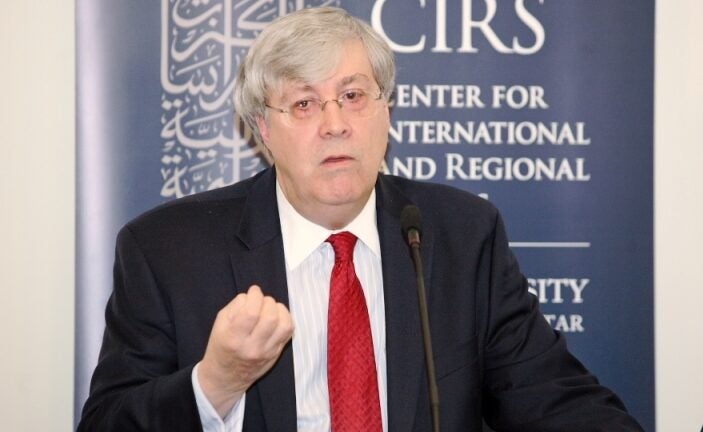Dialogue Series, Regional Studies
Lawrence Potter on the Rise and Fall of Port Cities in the Gulf

Lawrence G. Potter, a 2011-2012 CIRS Visiting Scholar and Adjunct Associate Professor of International Affairs at Columbia University, delivered a CIRS Monthly Dialogue lecture on “The Rise and Fall of Port Cities in the Gulf” on May 16, 2012. Potter’s lecture was designed to explain the economic, political, and ecological reasons why port cities in the Gulf came to prominence or declined over the centuries. As a conceptual introduction to the lecture, he argued that a distinction should be made between a port and a harbor. “A harbor,” Potter said, “is a physical concept, a shelter for ships;” whereas “a port is an economic concept, a center of exchange.”
Littoral settlements on the Gulf were born of maritime cultures based on pearling, fishing, and trade, allowing tribes to travel freely across waterways in search of ideal locations to pursue their livelihoods. The strength of these commercial and familial connections along the coast meant that “some tribes had settlements on both sides of the Gulf, most famously the Qawasim based in Sharjah and Ras al-Khaimah who temporarily governed Bandar Langeh,” Potter said.
The migratory and transitory nature of sea-faring cultures meant that “the Gulf was oriented outward, toward the Indian Ocean, rather than inward toward the Middle East, and was part of a cosmopolitan world of mixed race, religion, and ethnicity,” as well as language, Potter said. Because of these maritime ties, port cities have always maintained a degree of economic and cultural independence from their inland counterparts. Importantly, these cultures defied the limited borders of nation-states where “settlements along the Persian coast often had closer relations with those on the Arab side than those in the interior, due to ease of communication,” he explained. Multicultural connections, whether based on family ties or trading relationships, often shielded port communities from the sectarian strife that afflicted many other parts of the Middle East. This cosmopolitan history of Gulf ports is starkly different from that of the more settled inland cities of Isfahan, Shiraz, Tabriz, and Herat on the Iranian plateau. Historically, these were populated urban areas that had an established culture and that cultivated centuries of art and literature particular to a single geographical area.
“One striking fact about port cities in the Gulf is that many have had only a temporary period of fluorescence,” Potter said. In medieval times, the most important ports were to be found on the northern Persian shore of the Gulf, but in the 19th and 20th centuries, the ports on the southern Arab shore rose to prominence. Since ports are principally economic areas, their primary purpose is to facilitate regional and economic trade. If an environmental or political factor was to obstruct these trade routes in any way, “theKhalijis could easily move if dissatisfied. In a region where boats and not land constituted capital, it was easy to sail away and reestablish themselves elsewhere,” he argued.
The often harsh environment in the Gulf and lack of water and wood played key roles in the migration of populations from one port to establish another. Other reasons for abandoning a port include its physical destruction due to the harbor silting up. “In medieval times this happened to old Hormuz. In the 20th century, this happened to Sharjah, severely damaging its trade and giving the advantage to Dubai.” In order to overcome these environmental challenges and the lack of water and wood, some settlements imported fresh water and wood from nearby areas. Even though littoral settlements were maritime societies, the wood to build ships and dhows had to be imported from India and East Africa. Potter explained how such ecological challenges can have profound effects on the forming of a nation’s security apparatus by arguing that “the lack of wood was undoubtedly one reason why Iran did not have a navy until the twentieth century.”
In conclusion, Potter highlighted the continued trajectory regarding the importance of port cities in the Gulf. “Today, the Khalijis have overcome the challenges of climate and lack of water, and continue to excel as the businessmen that they always were. The port cities are multinational, as they always were. The modern shopping malls of Doha and Dubai are just a modern version of what the great emporiums of Hormuz and Muscat must have looked like,” he said.
Lawrence G. Potter has taught at Columbia University since 1996. A graduate of Tufts College, he received an M.A. in Middle Eastern Studies from the School of Oriental and African Studies, University of London, and a Ph.D. in History from Columbia. He taught in Iran for four years before the revolution. From 1984 to 1992 he was Senior Editor at the Foreign Policy Association. He specializes in the history of Iran and the Gulf and U.S. policy toward the Middle East.
Article by Suzi Mirgani, Manager and Editor for CIRS Publications